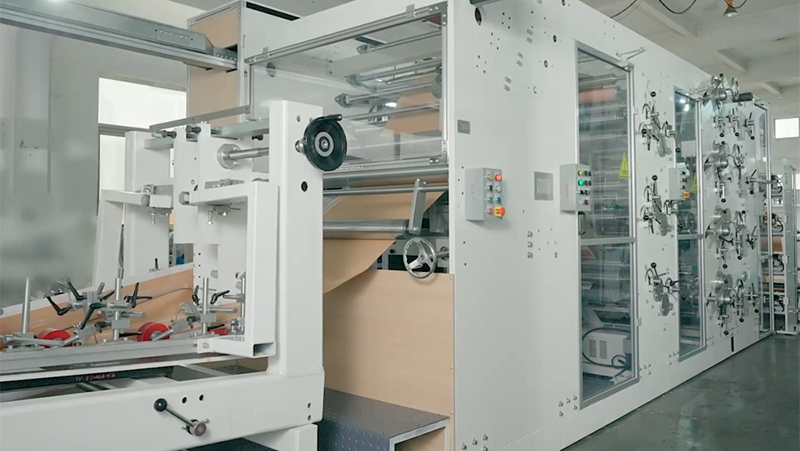Advancements in Touchscreen-Controlled Paper Bag Manufacturing Equipment
Release time:2025-05-14 Classification:Knowledge
The evolution of packaging technology has introduced innovative solutions to streamline production processes, and touchscreen-controlled paper bag equipment stands at the forefront of this transformation. Combining precision engineering with intuitive user interfaces, these systems redefine efficiency, accuracy, and adaptability in modern manufacturing environments. This article explores the technical features, operational benefits, and industrial applications of touchscreen-controlled paper bag machinery.

1. Core Features of Touchscreen-Controlled Paper Bag Equipment
Modern touchscreen-controlled paper bag systems integrate advanced automation with user-centric design. Key components include:
- Programmable Logic Controllers (PLCs): These ensure seamless coordination between mechanical components, enabling precise control over bag dimensions, folding patterns, and sealing mechanisms.
- High-Resolution Touchscreen Interfaces: Operators can input parameters, monitor real-time production data, and adjust settings via responsive, menu-driven displays.
- Modular Design: Equipment often supports interchangeable dies and tooling, allowing rapid switching between bag sizes and styles without manual recalibration.
- Sensor-Driven Quality Assurance: Optical sensors detect material inconsistencies, misalignments, or defects, triggering automatic adjustments to minimize waste.
2. Operational Advantages of Touchscreen Integration
The incorporation of touchscreen technology addresses longstanding challenges in paper bag production:
- Enhanced Precision: Manual adjustments are prone to human error, but digital input ensures exact specifications for bag length, width, and handle placement.
- Reduced Downtime: Pre-programmed recipes enable one-touch transitions between product designs, slashing changeover time by up to 70%.
- Data-Driven Optimization: Production metrics—such as speed, error rates, and material usage—are logged for analysis, supporting continuous process improvement.
- Operator Accessibility: Intuitive interfaces reduce training requirements, allowing staff to master operations within hours rather than days.
3. Technical Specifications and Customization
Touchscreen-controlled paper bag equipment is engineered to accommodate diverse industrial demands. Standard configurations typically include:
- Speed Range: 60–200 bags per minute, adjustable based on material thickness and complexity.
- Material Compatibility: Kraft paper, recycled substrates, laminated films, and biodegradable alternatives.
- Handle Options: Integrated systems for twisted, flat, or ribbon-style handles.
- Eco-Conscious Features: Energy-efficient motors and reduced glue consumption align with sustainability goals.
Customizable add-ons, such as inline printing units or automated stacking modules, further enhance versatility for specialized applications.
4. Industrial Applications and Market Relevance
This equipment caters to industries requiring high-volume, customizable paper bag solutions:
- Retail Packaging: Produce bags with branded prints, reinforced handles, or window cutouts for visual appeal.
- Food Service: Generate grease-resistant or compostable bags tailored to bakery, takeout, or grocery needs.
- E-Commerce: Durable, lightweight options optimized for shipping and reduced carbon footprints.
- Luxury Goods: Precision-finished bags with embossed textures or metallic accents for premium branding.
5. Maintenance and Longevity
To maximize equipment lifespan, manufacturers recommend:
- Routine Calibration: Periodic alignment checks for cutting blades and folding mechanisms.
- Software Updates: Regular firmware upgrades to access new features and security patches.
- Preventive Maintenance: Lubrication of moving parts and inspection of sensors/actuators.
Most systems include self-diagnostic tools accessible via the touchscreen, flagging potential issues before they escalate.
6. Future Trends in Paper Bag Automation
Emerging innovations promise to expand the capabilities of touchscreen-controlled systems:
- AI-Powered Predictive Maintenance: Algorithms analyze operational data to forecast component wear.
- IoT Integration: Remote monitoring via cloud platforms enables real-time troubleshooting and performance tracking.
- Hybrid Material Handling: Equipment adaptable to paper-plastic composites or plant-based polymers.
Touchscreen-controlled paper bag manufacturing equipment represents a paradigm shift in packaging automation. By merging tactile operational simplicity with industrial-grade precision, these systems empower businesses to meet escalating demands for speed, customization, and sustainability. As technology advances, such machinery will continue to play a pivotal role in shaping the future of eco-friendly packaging solutions.






